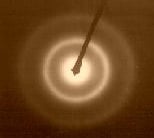| |
 |
| The diffraction pattern obtained with
firing a beam of electrons through a crystalline material.
This can only be explained if the electrons are considered
as waves. |
|
|
|
de Broglie said that this relationship
also held for other particles, like electrons. This was
confirmed by G.P. Thomson and C.J. Davisson in 1927 when
they demonstrated the diffraction of electron waves in the
crystal lattice of nickel. Ironically, G.P. Thomson did
this work about 30 years after his father, J.J. Thomson,
demonstrated the particle nature of electrons! de Broglie's
idea could also be applied to electrons moving around atoms.
Only orbits which could accommodate a whole number of wavelengths
would fit. This exactly confirmed what Bohr had postulated
in this atomic model!
de Broglie won the Nobel Prize in Physics in 1929 for
his discovery, followed by Thomson and Davisson in 1937. |